Health and environmental impact of transport
This article has multiple issues. Please help improve it or discuss these issues on the talk page. (Learn how and when to remove these messages)
|

| Part of a series on |
| Pollution |
|---|
 |
The health and environmental impact of transport is significant because transport burns most of the world's petroleum. This causes illness and deaths from air pollution, including nitrous oxides and particulates, and is a significant cause of climate change through emission of carbon dioxide.[3][4] Within the transport sector, road transport is the largest contributor to climate change.[3]
Environmental regulations in developed countries have reduced the individual vehicle's emission. However, this has been offset by an increase in the number of vehicles, and increased use of each vehicle (an effect known as the Jevons paradox).[3] Some pathways to reduce the carbon emissions of road vehicles have been considerably studied.[5] Energy use and emissions vary largely between modes, causing environmentalists to call for a transition from air and road to rail and human-powered transport, and increase transport electrification and energy efficiency.
Other environmental impacts of transport systems include traffic congestion and automobile-oriented urban sprawl, which can consume natural habitat and agricultural lands. By reducing transport emissions globally, it is predicted that there will be significant positive effects on Earth's air quality, acid rain, smog, and climate change.[6] Health effects of transport include noise pollution and carbon monoxide emissions.
While electric cars are being built to cut down CO2 emission at the point of use, an approach that is becoming popular among cities worldwide is to prioritize public transport, bicycles, and pedestrian movement. Redirecting vehicle movement to create 20-minute neighbourhoods[7] that promotes exercise while greatly reducing vehicle dependency and pollution. Some policies are levying a congestion charge[8] to cars for travelling within congested areas during peak time.
Types of effects
[edit]Emissions
[edit]The transportation sector is a major source of greenhouse gas emissions (GHGs) in the United States. An estimated 30 percent of national GHGs are directly attributable to transportation—and in some regions, the proportion is even higher. Transportation methods are the greatest contributing source of GHGs in the U.S., accounting for 47 percent of the net increase in total U.S. emissions since 1990.[9]
Land
[edit]Other environmental effects of transport systems include traffic congestion and automobile-oriented urban sprawl, which can consume natural habitat and agricultural lands. By reducing transportation emissions globally, it is predicted that there will be significant positive effects on Earth's air quality, acid rain, smog and climate change.[10]
Health
[edit]The health effects of transport emissions are also of concern. A recent survey of the studies on the effect of traffic emissions on pregnancy outcomes has linked exposure to emissions to adverse effects on gestational duration and possibly also intrauterine growth.[11]
As listed above direct effects such as noise pollution and carbon monoxide emissions create direct and harmful effects on the environment, along with indirect effects. The indirect effects are often of higher consequence which leads to the misconception that it's the opposite since it is frequently understood that initial effects cause the most damage. For example, particulates which are the outcome of incomplete combustion done by an internal combustion engine, are not linked with respiratory and cardiovascular problems since they contribute to other factors not only to that specific condition. Even though the environmental effects are usually listed individually there are also cumulative effects. The synergetic consequences of transport activities. They take into account the varied direct and indirect effects on an ecosystem. Climate change is the sum total result of several natural and human-made factors. 15% of global CO2 emissions are attributed to the transport sector.[12]
Mode
[edit]

The following table compares the emissions of the different transport means for passenger transport in Europe:[13]
| Transport means | Passengers average |
Emissions (g CO2/(km*pax)) |
|---|---|---|
| Train | 156 | 14 |
| Small car | 4 | 42 |
| Big car | 4 | 55 |
| Bus | 12.7 | 68 |
| Motorbike | 1.2 | 72 |
| Small car | 1.5 | 104 |
| Big car | 1.5 | 158 |
| Plane | 88 | 285 |
Aviation
[edit]Aviation emissions vary based on length of flight. For covering long distances, longer flights are a better investment of the high energy costs of take-off and landing than very short flights, yet by nature of their length inevitably use much more energy. CO2 emissions from air travel range from 0.24 kg CO2 per passenger mile (0.15 kg/km per passenger) for short flights down to 0.18 kg CO2 per passenger mile (0.11 kg/km per passenger) for long flights.[14][15] Researchers have been raising concern about the globally increasing hypermobility of society, involving frequent and often long-distance air travel and the resulting environmental and climate effects. This threatens to overcome gains made in the efficiency of aircraft and their operations.[16] Climate scientist Kevin Anderson raised concern about the growing effect of air transport on the climate in a paper[13] and a presentation[14] in 2008. He has pointed out that even at a reduced annual rate of increase in UK passenger air travel and with the government's targeted emissions reductions in other energy use sectors, by 2030 aviation would be causing 70% of the UK's allowable CO2 emissions.
Worse, aircraft emissions at stratospheric altitudes have a greater contribution to radiative forcing than do emissions at sea level, due to the effects of several greenhouses gases in the emissions, apart from CO2.[17] The other GHGs include methane (CH4), NOx which leads to ozone [O3], and water vapor. Overall, in 2005 the radiative forcing caused by aviation amounted to 4.9% of all human-caused radiative forcing on Earth's heat balance.[18]
Road transport
[edit]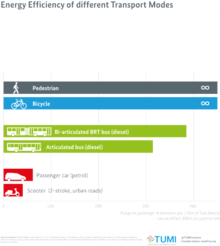
Cycling
[edit]Cycling has a low carbon-emission and low environmental footprint. A European study of thousands of urban dwellers found that daily mobility-related CO2 emissions were 3.2 kg (7.1 lb) of CO2 per person, with car travel contributing 70% and cycling 1% (including the entire lifecycle of vehicles and fuels). 'Cyclists' had 84% lower lifecycle CO2 emissions from all daily travel than 'non-cyclists', and the more people cycled on a daily basis, the lower was their mobility-related carbon footprint. Motorists who shifted travel modes from cars to bikes as their 'main method of travel' emitted 7.1 kg (16 lb) less CO2 per day.[19] Regular cycling was most strongly associated with reduced life cycle CO2 emissions for commuting and social trips.[19]
Changing from motorised to non-motorised travel behaviour can also have significant effects. A European study of nearly 2000 participants showed that an average person cycling 1 trip/day more and driving 1 trip/day less for 200 days a year would decrease mobility-related lifecycle CO2 emissions by about 0.5 tonnes over a year, representing a substantial share of average per capita CO2 emissions from transport (which are about 1.5 to 2.5 tonnes per year, depending on where you live).[20]
Cars
[edit]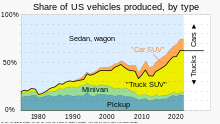
When burned, unleaded gasoline produces 8.91 kg (19.6 lb) of CO2 per gallon, while diesel produces 10.15 kg (22.4 lb).[23] CO2 emissions originating from ethanol are disregarded by international agreements however so gasoline containing 10% ethanol would only be considered to produce 8.02 kg (17.7 lb) of CO2 per gallon.[24] The average fuel economy for new light-duty vehicles sold in the US of the 2017 model year was about 24.9 MPG giving around 0.36 kg (0.79 lb) of CO2 per mile.[25] The Department of Transportation's MOBILE 6.2 model, used by regional governments to model air quality, uses a fleet average (all cars, old and new) of 20.3 mpg giving around 0.44 kg (0.97 lb) of CO2 per mile.[26]
In Europe, the European Commission enforced that from 2015 all new cars registered shall not emit more than an average of 0.13 kg (0.29 lb) of CO2 per kilometre (kg CO2/km). The target is that by 2021 the average emissions for all new cars is 0.095 kg (0.21 lb) of CO2 per kilometre.[27]
Buses
[edit]On average, inner city commuting buses emit 0.3 kg (0.66 lb) of CO2 per passenger mile (0.18 kg/km per passenger), and long distance (>20 mi, >32 km) bus trips emit 0.08 kg of CO2 per passenger mile (0.05 kg/km per passenger).[28] Road and transportation conditions vary, so some carbon calculations add 10% to the total distance of the trip to account for potential traffic jams, detours, and pit-stops that may arise.[14]
Rail
[edit]
On average, commuter rail and subway trains emit 0.17 kg (0.37 lb) of CO2 per passenger mile (0.11 kg/km per passenger), and long distance (>20 mi, >32 km) trains emit 0.19 kg (0.42 lb) of CO2 per passenger mile (0.12 kg/km per passenger).[28] Some carbon calculations add 10% to the total trip distance to account for detours, stop-overs, and other issues that may arise.[14]
Electric trains contributes relatively less to the pollution as pollution happens in the power plants which are lot more efficient than diesel driven engines.[29] Generally electric motors even when accounting for transmission losses are more efficient than internal combustion engines with efficiency further improving through recuperative braking.
Trains contain many different parts that have the potential to create noise. Wheels, engines and non-aerodynamic cargo are prone to vibrate at certain speeds. Noise caused from directly neighboring railways has the potential to lessen value to nearby property. In order to combat unbearable volumes resulting from railways, US diesel locomotives are required to be quieter than 90 decibels at 25 meters away since 1979. This noise, however, has been shown to be harmless to animals, except for horses who will become skittish.[30]
Railway cargo can be a cause of pollution.[30] Air pollution can occur from boxcars carrying materials such as iron ore, coal, soil, or aggregates and exposing these materials to the air. This can release nitrogen oxide, carbon monoxide, sulphur dioxide, or hydrocarbons into the air. Liquid pollution can come from railways contributing to a runoff into water sources, like groundwater or rivers and can result from spillage of fuels like oil into water supplies or onto land or discharge of human waste.[30]
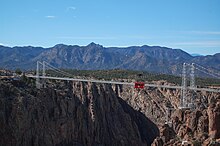
When railways are built in wilderness areas, the environment is visually altered by cuttings, embankments, dikes, and stilts.[30]
Shipping
[edit]The fleet emission average for delivery vans, trucks and big rigs is 10.17 kg (22.4 lb) CO2 per gallon of diesel consumed. Delivery vans and trucks average about 7.8 mpg (or 1.3 kg of CO2 per mile) while big rigs average about 5.3 mpg (or 1.92 kg of CO2 per mile).[31]

Discharges of sewage into water bodies can come from many sources, including wastewater treatment facilities, runoff from livestock operations, and vessels. These discharges have the potential to impair water quality, adversely affecting aquatic environments and increasing the risks to human health. While sewage discharges have potentially wide-ranging effects on all aquatic environments, the effects may be especially problematic in marinas, slow-moving rivers, lakes and other bodies of water with low flushing rates. Environmentally this creates invasive species that often drive other species to their extinction and cause harm to the environment and local businesses.[32]
Emissions from ships have much more significant environmental effects; many ships go internationally from port to port and are not seen for weeks, contributing to air and water pollution on its voyage. Emission of greenhouse gases displaces the amount of gas that allows for UV-rays through the ozone. Sulfur and nitrogen compounds emitted from ship will oxidize in the atmosphere to form sulfate and nitrate. Emissions of nitrogen oxides, carbon monoxide, and volatile organic compounds (VOC) will lead to enhanced surface ozone formation and methane oxidation, depleting the ozone. The effect of the international ship emission on the distribution of chemical compounds such as NOx, CO, O3, •OH, SO2, HNO3, and sulfate is studied using a global chemical transport model (CTM), the Oslo CTM2. In particular, the large-scale distribution and diurnal variation of the oxidants and sulfur compounds are studied interactively. Meteorological data (winds, temperature, precipitation, clouds, etc.) used as input for the CTM calculations are provided by a weather prediction model.[33]
Shipping Emissions Factors:[34]
| Mode of Transport | kg of CO2 per Ton-Mile |
|---|---|
| Air cargo | 0.8063 |
| Truck | 0.1693 |
| Train | 0.1048 |
| Sea freight | 0.0403 |
The road haulage industry is contributing around 20% of the UK's total carbon emissions a year, with only the energy industry having a larger contribution, at around 39%. Road haulage is a significant consumer of fossil fuels and associated carbon emissions – HGV vehicles account for almost 20 percent of total emissions.[35]
Mitigation of environmental effects
[edit]This section needs expansion. You can help by adding to it. (May 2013) |
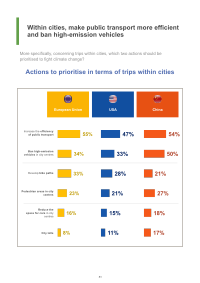
Sustainable transport
[edit]Sustainable transport is transport with either lower environmental footprint per passenger, per distance or higher capacity. Typically sustainable transport modes are rail, bicycle and walking.
Road-rail parallel layout
[edit]
Road-Rail Parallel Layout is a design option to reduce the environmental effects of new transportation routes by locating railway tracks alongside a highway. In 1984 the Paris—Lyon high-speed rail route in France had about 14% parallel layout with the highway, and in 2002, 70% parallel layout was achieved with the Cologne–Frankfurt high-speed rail line.

Involvement
[edit]Mitigation does not entirely involve large-scale changes such as road construction, but everyday people can contribute. Walking, cycling trips, short or non-commute trips, can be an alternate mode of transportation when travelling short or even long distances. A multi-modal trip involving walking, a bus ride, and bicycling may be counted solely as a transit trip. Economic evaluations of transportation investments often ignore the true effects of increased vehicular traffic—incremental parking, traffic accidents, and consumer costs—and the real benefits of alternative modes of transport. Most travel models do not account for the negative effects of additional vehicular traffic that result from roadway capacity expansion and overestimate the economic benefits of urban highway projects. Transportation planning indicators, such as average traffic speeds, congestion delays, and roadway level of service, measure mobility rather than accessibility.[37]
Climate change is a factor that 67% of Europeans consider when choosing where to go on holiday. Specifically, people under the age of 30 are more likely to consider climate implications of travelling to vacation spots.[38][39] 52% of young Europeans, 37% of people ages 30–64 and 25% of people aged above 65, state that in 2022 they will choose to travel by plane. 27% of young people claim they will travel to a faraway destination.[40][41]
Europeans expect lifestyle changes to experience great transformation in the next 20 years. 31% of respondents to a climate survey conducted in 2021 believe that most people will no longer own their own vehicle, while 63% believe that teleworking will become the norm to reduce emissions and mitigate the effects of climate change. 48% predict that energy quotas will be individually assigned.[42]
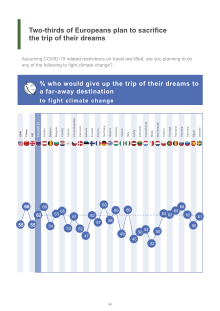
Influence of e-commerce
[edit]This section is written like a personal reflection, personal essay, or argumentative essay that states a Wikipedia editor's personal feelings or presents an original argument about a topic. (August 2019) |
As large retail corporations in recent years have focused attention on eCommerce, many have begun to offer fast (e.g. 2-day) shipping[citation needed]. These fast shipping options get products and services to the hands of buyers faster than ever before, but have they are negative externalities on public roads and climate change[citation needed]. A survey in 2016 by UPS shows that 46% of online shoppers abandoned an unused shopping cart due to a shipping time that was way too long and that 1 and 3 online shoppers look at the speed of delivery from the marketplaces they buy from.[43] Consumers are demanding the fast delivery of goods and services. AlixPartners LLP found that consumers expect to wait an average of 4.8 days for delivery, down from 5.5 days in 2012. And the share of those who are willing to wait more than five days has declined to 60% from 74% in four years.[44]
E-commerce shopping can be seen as the best way to reduce one's carbon footprint. Yet, this is only true to some extent. Shopping online is less energy intensive than driving to a physical store location and then driving back home. This is because shipping can take advantage of economies of scale. However, these benefits are diminished when e-commerce stores package items separately or when customers buy items separately and do not take the time to one stop shop.[45] For large stores with a large online presence, they can have millions of customers opting for these shipping benefits. As a result, they are unintentionally increasing carbon emissions from not consolidating their purchases. Josué Velázquez-Martínez, a sustainable logistics professor at MIT notes that "if you are willing to wait a week for shipping, you just kill 20 trees instead of 100 trees."[46] The only time shipping works in being less energy intensive is when customer do not choose rush delivery, which includes 2-day shipping. M. Sanjayan, the CEO of Conservation International, explains that getting your online purchase delivered at home in just two days puts more polluting vehicles on the road.[47] In addition to standard shipping, consumers must be satisfied with their purchases so that they do not constantly returns items. By returning shipments on standard shipping, the positive contribution to environment is being taken back. In research done by Vox, they found in 2016 transportation overtook power plants as the top prouder of carbon dioxide emissions in the US for the first time since 1979.[48] These environmental issues came from nearly a quarter of transportation trucks that either carry medium and heavy duty loads of merchandise; these trucks are often the ones doing e-commerce shipping.

Since 2009, UPS deliveries have increased by 65%.[49] With the increase in deliveries, there is a demand for trucks on the road, resulting in more carbon emissions in our atmosphere. More recently, there has been research to help combat greenhouse gas emission to the atmosphere with better traffic signals. These WiFi signals cut down on wait time at stop lights and reduce wasting fuel. These signals help automobiles adjust their velocity so that they can increase their chances of getting through the light, smoothing travel patterns and obtaining fuel-economy benefits. These small adjustments result in big changes in fuel savings. The cities that have started implementing smart light technology such as San Jose, CA and Las Vegas, NV. Light technology has shown to save 15-20% in fuel savings.[45] According to the United States Environmental Protection Agency, transportation is the second leading source of GHG emission behind electricity and project that by 2050 freight transportation emissions will pass passenger vehicle emissions.[49] Another technological advancements is truck platooning, trucks are able to send signals to neighboring trucks about their speed. This communication between vehicles reduces congestion on the roads and reduce drag, increasing fuel savings by 10 to 20%.[45]
With these tech implementations in major cities and towns, there is the ability to reach an optimal level of pollution given the rise of e-commerce shipments. The figure above illustrates that decreasing emissions would result in the equilibrium for the market of shipping population, which can be done by consolidating packages, light technology, or truck platooning.
See also
[edit]- Bicycle commuting – Use of a bicycle to travel
- Carbon footprint – Concept to quantify greenhouse gas emissions from activities or products
- Car-free movement – Movement to reduce the use of private vehicles
- Circular economy#Automotive industry – Production model to minimise wastage and emissions
- Durability – Ability of a product to continue to function
- Emission intensity – Emission rate of a pollutant
- Environmental effects of transport in Australia
- Externalities of automobiles – Impacts of car use
- Free public transport – Public transport not funded by fares from passengers
- Health impact of light rail systems
- List of most-polluted cities by particulate matter concentration
- Mobile source air pollution – Air pollution emitted by motor vehicles, airplanes, locomotives, and other engines
- Planned obsolescence – Policy of planning or designing a product with an artificially limited useful life
- Remote work – Employees working from any location
- Service life – Period of time where an object can fulfill a function
- Sustainable product – Environmentally-beneficial products
- Throwaway society – Human society strongly influenced by consumerism
- Vehicle recycling – Dismantling of vehicles for spare parts
References
[edit]- ^ "Diesel 101 | Clean Air Northeast". cleanairnortheast.epa.gov. Retrieved 2024-11-19.
- ^ "Delhi Air Pollution: 7 biggest causes of air pollution and effective preventive measures". The Times of India. 2024-11-13. ISSN 0971-8257. Retrieved 2024-11-19.
- ^ a b c Fuglestvet et al., Center for International Climate and Environmental Research (2007). "Climate forcing from the transport sectors" (PDF).
- ^ Worldwatch Institute (16 January 2008). "Analysis: Nano Hypocrisy?". Archived from the original on 13 October 2013. Retrieved 12 December 2009.
- ^ "Carbon Pathways Analysis – Informing Development of a Carbon Reduction Strategy for the Transport Sector – Claverton Group". claverton-energy.com.
- ^ Environment Canada. "Transportation". Archived from the original on July 13, 2007. Retrieved 30 July 2008.
- ^ Planning (2020-09-09). "20-minute neighbourhoods". Planning. Retrieved 2020-09-26.
- ^ "Congestion Charge (Official)". Transport for London. Retrieved 2020-09-26.
- ^ "Climate and Energy Resources for State, Local, and Tribal Governments". US Environmental Protection Agency. Retrieved 2016-04-14.
- ^ Environment Canada. "Transportation". Archived from the original on July 13, 2007. Retrieved 30 July 2008.
- ^ Pereira, G. et al. (2010) "Residential exposure to traffic emissions and adverse pregnancy outcomes". S.A.P.I.EN.S. 3 (1)
- ^ Rodrigue, Dr. Jean-Paul. "The Environmental Impacts of Transportation". people.hofstra.edu. Archived from the original on 2018-01-31. Retrieved 2016-04-14.
- ^ "CO2 emissions from passenger transport". eea.europa.eu.
- ^ a b c "How We Calculate Your Carbon Footprint". Archived from the original on 2012-01-03. Retrieved 2011-12-29.
- ^ "[SafeClimate] measuring and reporting | tools". Archived from the original on 2008-03-27. Retrieved 2010-04-23.
- ^ Gössling S, Ceron JP, Dubois G, Hall CM, Gössling IS, Upham P, Earthscan L (2009). Hypermobile travelers and Implications for Carbon Dioxide Emissions Reduction. In: Climate Change and Aviation: Issues, Challenges, and Solutions, London. The chapter: (PDF) Archived June 19, 2010, at the Wayback Machine
- ^ Schumann, Ulrich (2011). "American Institute of Aeronautics and Astronautics: Potential to reduce the climate impact of aviation by flight level changes" (PDF). Retrieved 2022-06-30.
- ^ Lee D.S., Pitari G., Grewe V., Gierens K., Penner J.E., Petzold A., Prather M.J., Schumann U., Bais A., Berntsen T., Iachetti D., Lim L.L., Sausen R. (2010). Transport impacts on atmosphere and climate: Aviation. In – Atmospheric Environment Transport Impacts on Atmosphere and Climate: The ATTICA Assessment Report. 44:37:pp.4678-4734.
- ^ a b Brand, Christian; Dons, Evi; Anaya-Boig, Esther; Avila-Palencia, Ione; Clark, Anna; de Nazelle, Audrey; Gascon, Mireia; Gaupp-Berghausen, Mailin; Gerike, Regine; Götschi, Thomas; et, al. (2021-04-01). "The climate change mitigation effects of daily active travel in cities". Transportation Research Part D: Transport and Environment. 93: 102764. Bibcode:2021TRPD...9302764B. doi:10.1016/j.trd.2021.102764. hdl:10230/53376.
- ^ Brand, Christian; Götschi, Thomas; Dons, Evi; Gerike, Regine; Anaya-Boig, Esther; Avila-Palencia, Ione; de Nazelle, Audrey; Gascon, Mireia; Gaupp-Berghausen, Mailin; Iacorossi, Francesco; Kahlmeier, Sonja (2021-03-01). "The climate change mitigation impacts of active travel: Evidence from a longitudinal panel study in seven European cities". Global Environmental Change. 67: 102224. Bibcode:2021GEC....6702224B. doi:10.1016/j.gloenvcha.2021.102224. hdl:10044/1/89043. ISSN 0959-3780. S2CID 233814021.
- ^ "Highlights of the Automotive Trends Report". EPA.gov. U.S. Environmental Protection Agency (EPA). 12 December 2022. Archived from the original on 2 September 2023.
- ^ Cazzola, Pierpaolo; Paoli, Leonardo; Teter, Jacob (November 2023). "Trends in the Global Vehicle Fleet 2023 / Managing the SUV Shift and the EV Transition" (PDF). Global Fuel Economy Initiative (GFEI). p. 3. doi:10.7922/G2HM56SV. Archived (PDF) from the original on 26 November 2023.
- ^ "U.S. Energy Information Administration (EIA)". Archived from the original on 2004-11-01. Retrieved 2009-08-21.
- ^ "How much carbon dioxide is produced by burning gasoline and diesel fuel? – FAQ – U.S. Energy Information Administration (EIA)". eia.gov.
- ^ Highlights of the Automotive Trends Report | US EPA
- ^ "Vehicles and Engines" (PDF). US Environmental Protection Agency. 2016-08-16.
- ^ "Reducing CO2 emissions from passenger cars". ec.europa.eu. 2016-11-23.
- ^ a b "Archived copy". Archived from the original on 2016-01-12. Retrieved 2010-04-23.
{{cite web}}: CS1 maint: archived copy as title (link) - ^ "'Dramatically more powerful': world's first battery-electric freight train unveiled". the Guardian. 2021-09-16. Retrieved 2021-09-21.
- ^ a b c d Carpenter, T.G. (1994). The Environmental Impact of Railways. New York: John Wiley & Sons.
- ^ "403 - Forbidden: Access is denied" (PDF).
- ^ "Vessel Sewage Discharges: Homepage". US Environmental Protection Agency. 2015-09-15. Retrieved 2016-04-14.
- ^ Endresen, Øyvind; Sørgård, Eirik; Sundet, Jostein K.; Dalsøren, Stig B.; Isaksen, Ivar S. A.; Berglen, Tore F.; Gravir, Gjermund (2003-09-16). "Emission from international sea transportation and environmental impact". Journal of Geophysical Research: Atmospheres. 108 (D17): 4560. Bibcode:2003JGRD..108.4560E. doi:10.1029/2002JD002898. ISSN 2156-2202.
- ^ "Klimakiller Flugverkehr - zur Umweltrelevanz des Flughafens Hamburg- Eine Information der Notgemeinschaft der Flughafenanlieger Hamburg". fluglaerm.de. Archived from the original on 2010-03-07. Retrieved 2010-04-23.
- ^ "Reducing your Road Haulage Carbon Emissions – Return Loads". returnloads.net.
- ^ a b Bank, European Investment (2021-05-31). The EIB Climate Survey 2020-2021 - The climate crisis in a COVID-19 world: calls for a green recovery. European Investment Bank. ISBN 978-92-861-5021-0.
- ^ "Transportation Solutions | Reimagine!". www.reimaginerpe.org. Retrieved 2016-04-14.
- ^ "2021-2022 EIB Climate Survey, part 2 of 3: Shopping for a new car? Most Europeans say they will opt for hybrid or electric". EIB.org. Retrieved 2022-04-04.
- ^ "2021-2022 EIB Climate Survey, part 1 of 3: Europeans sceptical about successfully reducing carbon emissions by 2050, American and Chinese respondents more confident". EIB.org. Retrieved 2022-03-30.
- ^ "2021-2022 EIB Climate Survey, part 2 of 3: Shopping for a new car? Most Europeans say they will opt for hybrid or electric". EIB.org. Retrieved 2022-04-04.
- ^ "2021-2022 EIB Climate Survey, part 1 of 3: Europeans sceptical about successfully reducing carbon emissions by 2050, American and Chinese respondents more confident". EIB.org. Retrieved 2022-03-30.
- ^ "2021-2022 EIB Climate Survey, part 3 of 3: The economic and social impact of the green transition". EIB.org. Retrieved 2022-03-30.
- ^ "UPS Pulse of the Online Shopper | UPS - United States". www.ups.com. Archived from the original on 2019-05-15. Retrieved 2019-03-13.
- ^ Chao, Loretta (2016-06-13). "Online Shoppers Want Delivery Faster, Cheaper, Survey Shows". Wall Street Journal. ISSN 0099-9660. Retrieved 2019-03-13.
- ^ a b c Murdock, Andy (2017-11-17). "The environmental cost of free 2-day shipping". Vox. Retrieved 2019-03-13.
- ^ "Amazon's new environmental report will show how bad two-day shipping is". www.msn.com. Retrieved 2019-03-13.
- ^ "Super-Fast Shipping Comes With High Environmental Costs". NPR.org. Retrieved 2019-03-13.
- ^ Brad Plumer (2016-06-13). "Power plants are no longer America's biggest climate problem. Transportation is". Vox. Retrieved 2022-12-01.
- ^ a b "Learn about SmartWay". US Environmental Protection Agency. 2016-04-29. Retrieved 2019-03-13.
External links
[edit]- Personal Transportation Factsheet by the University of Michigan's Center for Sustainable Systems
- Comparison of CO2 Emissions by Different Modes of Transport by the International Chamber of Shipping
- Nate Berg (January 5, 2016). "The future of freight: More shipping, less emissions?". Archived from the original on November 10, 2017. Retrieved November 10, 2017.
- John Schwartz (September 27, 2016). "An App to Help Save Emissions (and Maybe Money) When Buying a Car". NYT. Retrieved September 27, 2016.
